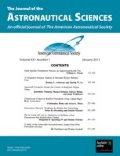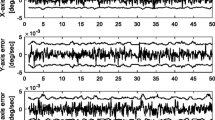Your gracious self, embrace but my direction.
William Shakespeare (1564–1616) The Winter’s Tale, Act IV, scene iv
Abstract
The predicted directions are examined as effective measurements of spacecraft attitude. It is shown that two linearly independent predicted directions are a sufficient statistic for the attitude, and that these two effective measurements can be chosen to be arbitrary directions as long as they are not parallel or antiparallel. However, the correct implementation of the predicted directions in maximum-likelihood estimation of the attitude is complicated by the form of the covariance matrix for each and their mutual correlation. Thus, the predicted directions, which differ greatly from the equivalent direction measurements presented earlier, are not useful as a practical vehicle for attitude data fusion. Unlike the equivalent directions, the predicted directions are always physically meaningful. Unfortunately, they are also almost physically meaningless, as we shall see. Nonetheless, they are of obvious theoretical interest and worthy of a careful examination. The predicted directions can be shown to be “equivalent” measurements for the TRIAD algorithm.
Similar content being viewed by others
References
SHUSTER, M. D. “Effective Direction Measurements for Spacecraft Attitude: I. Equivalent Directions,” The Journal of the Astronautical Sciences, Vol. 55, No. 4, October-December 2007, pp. 463–478.
SHUSTER, M. D. and OH, S. D. “Three-Axis Attitude Determination from Vector Observations,” Journal of Guidance and Control, Vol. 4, No. 1, January-February 1981, pp. 70–77.
SHUSTER, M. D. “Maximum Likelihood Estimation of Spacecraft Attitude,” The Journal of the Astronautical Sciences, Vol. 37, No. 1, January-March, 1989, pp. 79–88.
WAHBA, G. “Problem 65-1: A Least Squares Estimate of Spacecraft Attitude,” SIAM Review, Vol. 7, No. 3, July 1965, p. 409.
MARKLEY, F. L. and MORTARI, M. “Quaternion Attitude Estimation Using Vector Measurements,” The Journal of the Astronautical Sciences, Vol. 48, Nos. 2 and 3, April-September 2000, pp. 359–380.
CHENG, Y. and SHUSTER, M. D. “Robustness and Accuracy of the QUEST Algorithm,” presented as paper AAS-07-102, 17th Space Flight Mechanics Meeting, Sedona, Arizona, January 28-February 2, 2007; Proceedings: Advances in the Astronautical Sciences, Vol. 127, 2007, pp. 41–61.
CHENG, Y. and SHUSTER, M. D. “The Speed of Attitude Estimation,” presented as paper AAS- 07-105 at the 17th Space Flight Mechanics Meeting, Sedona, Arizona, January 28-February 2, 2007; Proceedings: Advances in the Astronautical Sciences, Vol. 127, 2007, pp. 101–116.
SHUSTER, M. D. “A Survey of Attitude Representations,” The Journal of the Astronautical Sciences, Vol. 41, No. 4, October-December 1993, pp. 439–517.
BLACK, H. D. “A Passive System for Determining the Attitude of a Satellite,” AIAA Journal, Vol. 2, July 1964, pp. 1350–1351.
CHENG, Y. and SHUSTER, M. D. “QUEST and the Anti-QUEST: Good and Evil Attitude Estimation,” The Journal of the Astronautical Sciences, Vol. 53, No. 3, July-September, 2005, pp. 337–351.
TANYGIN, S. and SHUSTER, M. D. “The Many TRIAD Algorithms,” presented as paper AAS-07-104 at the AAS/AIAA 17th Space Flight Mechanics Meeting, Sedona, Arizona, January 28-February 2, 2007; Proceedings: Advances in the Astronautical Sciences, Vol. 127, 2007, pp. 81–99 (in press).
SHUSTER, M. D. “The TRIAD Algorithm as Maximum Likelihood Estimation,” The Journal of the Astronautical Sciences, Vol. 54, No. 1, January-March, 2006, pp. 113–123.
SORENSON, H. Parameter Estimation, Marcel Dekker, New York, 1980.
SHAKESPEARE, W. Hamlet, Prince of Denmark, Act V, scene i, in CRAIG, W. J. (ed.), The Oxford Shakespeare, Oxford University Press, Oxford, United Kingdom, 1905 (reprinted many times).
SHUSTER, M. D. “Constraint in Attitude Estimation Part I: Constrained Estimation,” The Journal of the Astronautical Sciences, Vol. 51, No. 1, January-March, 2003, pp. 51–74.
SHUSTER, M. D. “Effective Direction Measurements for Spacecraft Attitude: III. Defective Directions and Data Fusion,” The Journal of the Astronautical Sciences, Vol. 55, No. 4, October-December 2007, pp. 493–510.
SHUSTER, M. D. “The Generalized Wahba Problem,” The Journal of the Astronautical Sciences, Vol. 54, No. 2, April-June 2006, pp. 245–259.
Author information
Authors and Affiliations
Corresponding author
Rights and permissions
About this article
Cite this article
Shuster, M.D. Effective direction measurements for spacecraft attitude: II. Predicted directions. J of Astronaut Sci 55, 479–492 (2007). https://doi.org/10.1007/BF03256537
Published:
Issue Date:
DOI: https://doi.org/10.1007/BF03256537




